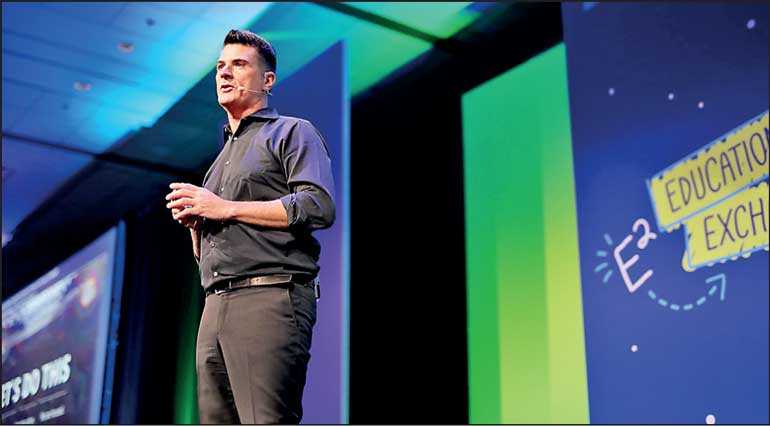Wednesday Apr 02, 2025
Wednesday Apr 02, 2025
Friday, 5 April 2019 00:00 - - {{hitsCtrl.values.hits}}

By Uditha Jayasinghe
in Paris
Governments of developing countries with fewer resources must be extremely clear about the overall vision they have for their education sector with special focus on enabling teachers and learning outcomes, before they focus on devices, top global education expert said yesterday.
Microsoft Worldwide Education Vice President Anthony Salcito believes that developing countries with student populations that have relatively low exposure to technology in classrooms are not necessarily at a disadvantage but could adapt the best global practices to leapfrog ahead.
“I work with the Sri Lankan Ministry on Education transformation and priorities. Emerging countries that have less technology foundation are in a better position to evolve and leapfrog, partly because the infrastructure can be leveraging all the experiences around the world. But everything has to be done purposely, so while we are learning what skills are relevant for students futures, countries that don’t have the means to fail have to be more precise in their investment and use technology not for the sake of technology but to improve learning outcomes, Salcito told the Daily FT on the side-lines of the E2 Education Exchange Conference.
He called for governments to take a holistic and long term view of how their education sector can evolve rather than focusing only on providing a device to students. The Sri Lankan Government has announced that it plans to provide tabs to all students, which has triggered heated debate on whether it was the best way to encourage technology adaptation in schools.
“What often happens in emerging economies is leaders who are driving hope for change and trying to revitalise education systems and outcomes will often use technology as a tool to inspire others and they will usually start with an acquisition agenda. ‘I will buy a device for every student and we are going to outfit every class for the internet’, for example. Those proclamations are often misguided because they make it about the thing rather than the actual people transformation and what we know is that the most important element we have to shift is the mindset of students and educators for the future.”
Putting device acquisition first could also trigger challenges from stakeholders such as teacher unions, and reduce public buy in because people will debate the advantages of technology versus other investments or even result in readiness gaps because some schools will simply not be ready digitally, have infrastructure or physical space to use the device effectively, Salcito pointed out.
“So what you want to is put people and learning outcomes first and use technology as a tool. What we have been talking about with the Sri Lankan Ministry is to actually start with a bold vision for change that is abstract. This means as opposed to saying our goal is to buy a device for every kid, our goal is to have the best students in the world or to create the most advanced education system and then the activities, whether it is buying devices or providing internet to schools is connected to that journey but aren’t the end point expectation.”
“What you want to do is bring the hope for a longer term evolution, which may take decades. When resources are tight you have to actually be very clear rather than focusing on device acquisition only. Readiness of educators and school leaders is critical,” he added.
More countries are facing the challenge of technology adaptation as they attempt to deal with how to spur economic growth through job creation, Salcito observed. As every economy in Asia is developing there is a great recognition of work place dynamic shifts and the opportunity to grow GDP through job creation, which can only happen if students are aligned to future needs of the workplace. However, governments have to be judicious about how this can be done and need long term plans, he observed.
Discover Kapruka, the leading online shopping platform in Sri Lanka, where you can conveniently send Gifts and Flowers to your loved ones for any event including Valentine ’s Day. Explore a wide range of popular Shopping Categories on Kapruka, including Toys, Groceries, Electronics, Birthday Cakes, Fruits, Chocolates, Flower Bouquets, Clothing, Watches, Lingerie, Gift Sets and Jewellery. Also if you’re interested in selling with Kapruka, Partner Central by Kapruka is the best solution to start with. Moreover, through Kapruka Global Shop, you can also enjoy the convenience of purchasing products from renowned platforms like Amazon and eBay and have them delivered to Sri Lanka.
Discover Kapruka, the leading online shopping platform in Sri Lanka, where you can conveniently send Gifts and Flowers to your loved ones for any event including Valentine ’s Day. Explore a wide range of popular Shopping Categories on Kapruka, including Toys, Groceries, Electronics, Birthday Cakes, Fruits, Chocolates, Flower Bouquets, Clothing, Watches, Lingerie, Gift Sets and Jewellery. Also if you’re interested in selling with Kapruka, Partner Central by Kapruka is the best solution to start with. Moreover, through Kapruka Global Shop, you can also enjoy the convenience of purchasing products from renowned platforms like Amazon and eBay and have them delivered to Sri Lanka.